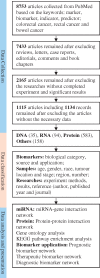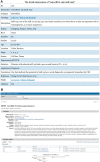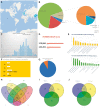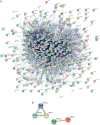CBD: a biomarker database for colorectal cancer
- PMID: 29846545
- PMCID: PMC6007224
- DOI: 10.1093/database/bay046
CBD: a biomarker database for colorectal cancer
Abstract
Colorectal cancer (CRC) biomarker database (CBD) was established based on 870 identified CRC biomarkers and their relevant information from 1115 original articles in PubMed published from 1986 to 2017. In this version of the CBD, CRC biomarker data were collected, sorted, displayed and analysed. The CBD with the credible contents as a powerful and time-saving tool provide more comprehensive and accurate information for further CRC biomarker research. The CBD was constructed under MySQL server. HTML, PHP and JavaScript languages have been used to implement the web interface. The Apache was selected as HTTP server. All of these web operations were implemented under the Windows system. The CBD could provide to users the multiple individual biomarker information and categorized into the biological category, source and application of biomarkers; the experiment methods, results, authors and publication resources; the research region, the average age of cohort, gender, race, the number of tumours, tumour location and stage. We only collect data from the articles with clear and credible results to prove the biomarkers are useful in the diagnosis, treatment or prognosis of CRC. The CBD can also provide a professional platform to researchers who are interested in CRC research to communicate, exchange their research ideas and further design high-quality research in CRC. They can submit their new findings to our database via the submission page and communicate with us in the CBD.Database URL: http://sysbio.suda.edu.cn/CBD/.
Figures







References
-
- Force, USPST., Bibbins-Domingo K., Grossman D.C., Curry S.J.. et al. (2016) Screening for colorectal cancer: US preventive services task force recommendation statement. JAMA, 315, 2564–2575. - PubMed
-
- Siegel R., Desantis C., Jemal A. (2014) Colorectal cancer statistics, 2014. CA Cancer J. Clin., 64, 104–117. - PubMed
-
- Ferlay J., Soerjomataram I., Dikshit R.. et al. (2015) Cancer incidence and mortality worldwide: sources, methods and major patterns in GLOBOCAN 2012. Int. J. Cancer, 136, E359–E386. - PubMed
-
- National Cancer Institute. (2017) Surveillance, Epidemiology, and End Results (SEER). https://seercancergov/statfacts/html/colorecthtml (12 October 2017, date last accessed).
-
- Torre L.A., Siegel R.L., Ward E.M.. et al. (2016) Global cancer incidence and mortality rates and trends—an update. Cancer Epidemiol. Biomarkers Prev., 25, 16–27. - PubMed
Publication types
MeSH terms
Substances
LinkOut - more resources
Full Text Sources
Other Literature Sources
Medical

